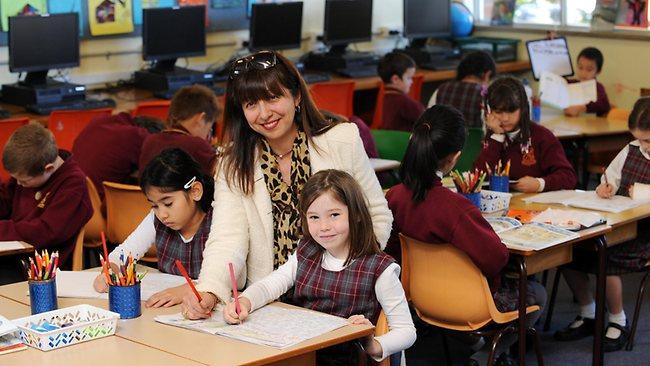Lips shut, backs straight, eyes down: how keeping still is a learning experience
STILL bodies, busy brains sums up the teaching approach taken by Roula Dunkerley in her classroom.

STILL bodies, busy brains sums up the teaching approach taken by Roula Dunkerley in her classroom.
Her composite class of Years 1 and 2 students at Brookvale Public School in Sydney's north is notable for its calm and quiet atmosphere - not characteristics usually associated with a group of 22 six and seven year olds.
Ms Dunkerley believes part of her job is to teach her young students the art of sitting still, concentrating and working on one's own - skills often overlooked in today's classrooms.
"We have the five Ls in my classroom: legs, lips, look, listen, learn," she said.
"A still body allows the brain to be active; someone rollicking around on the floor is not focusing on what you, or they, are doing."
While school syllabuses once explicitly set out the physical skills children should develop as part of a repertoire of scholarly habits, education researcher Megan Watkins said this emphasis had disappeared from modern-day curriculums.
Dr Watkins, a senior lecturer in education at the University of Western Sydney, said certain habits and skills such as sitting at a desk and holding a pen correctly, and working independently made aspects of learning easier.
"School isn't just about teaching kids mind skills; it's also about teaching their bodies," she said.
"Different types of learning require different forms of embodiment, different ways the body has to perform to be effective.
"There's a certain discipline involved in academic endeavour, but it flies under the radar because people assume it's natural. But kids have to learn . . . how to sit still, to concentrate on something for an extended period, and work by themselves."
Ms Dunkerley, who was part of a year-long research project into teaching strategies conducted by Dr Watkins, agreed that noisy, restless students were often considered as misbehaving. She said it was important children learned how to be quiet and still. "Many people don't have that expectation of children," she said.
"I don't think it's bad parenting, I think some people don't mind their children being loud and boisterous, but I think every child needs to learn there's a time to be still, to be quiet and to listen."
Ms Dunkerley also teaches her class the bodily habits they need to develop: backs against their chairs, fists between their tummies and the table, feet on the ground, heads up and not too close to the desk. "It's very important, otherwise the body starts to ache," she said. "If they're leaning all over the table with their head down, I think they tend to drift off. Having a still body and a body that's upright and erect but still comfortable is really important for writing, and I sure when they're using their pencil that they can take their fourth finger off the pencil to ensure their grip is not too tight."
Dr Watkins said school syllabus and curriculum documents once emphasised the need to develop habits for learning in students, and the physical skills required to study. The 1922 English syllabus in NSW says education is grounded in "the formation of habits; muscle and nerve habits, thought habits and emotional habits", with the school and the teacher bearing responsibility for a child acquiring these abilities.
"Habit-forming is an important part of education and its laws should be observed in all teaching," it says.
By 1974, the term "habit" had disappeared from the syllabus, and teaching was replaced with "opportunities" for learning.
Dr Watkins recently published a book, Discipline and Learn: Bodies, Pedagogy and Writing, on her project, in which she observed the different strategies used by six teachers in two primary schools in Sydney to teach students to write.
The teachers at one school in a disadvantaged area in Sydney made greater use of group and independent learning activities, casting the teacher in the role of facilitator rather than instructor, and the classrooms tended to be "relaxed learning environments with seemingly little restraint on talk of movement".
In contrast, the other school, in a more affluent area and considered one of the state's best academic performers, had a much more teacher-directed approach, and the teachers placed far more restrictions on their students within the classroom.
Teachers saw their role as not simply supporting but "explicitly directing their students' learning".
The impact of the different teaching styles on students' bodies "was considerable", Dr Watkins writes.
The use of relaxed disciplinary codes at the school in the disadvantaged area seemed to confirm students' existing habits, "which were generally not conducive to scholarly labour".
"A considerable proportion of students in the years 3 and 5 classes . . . experienced great difficulty with writing. They still hadn't habituated the mechanics of the process," the study says.
At the other school, the teachers understood that "learning requires bodily composure enabling students to apply themselves to their work".

